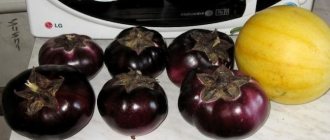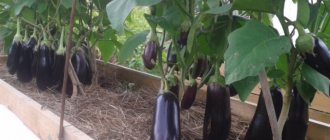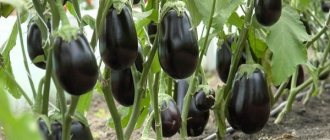Description of the variety
Eggplant "Mishutka", as noted earlier, is a late-ripening variety. The plant can be grown both in greenhouse conditions and in open ground.
- The time for full fruit ripening is 130-145 days.
- Productivity is high.
- The weight of the fetus can reach 250 grams.
Eggplants of this variety are pear-shaped or round and dark purple, almost black. The pulp is white, dense and tasty; it does not darken after cutting.
The Mishutka eggplant has one striking feature, thanks to which it produces high yields: the simultaneous formation of two or three fruits on one cluster.
Eggplant Mishutka. Analytical report
Now it’s time to sum up the results of testing the Mishutka eggplant. “An early-ripening, high-yielding variety, the period from germination to technical ripeness is 100-115 days. Designed for growing in open ground and under film covers. Productivity 8-9 kg/m2. Plants are closed and tall. The fruits are pear-shaped, long, weighing 250-450 g. The pulp is white, dense, tender, without bitterness. The taste of the products is excellent. Recommended for various culinary processing, canning and freezing. The variety is distinguished by the fact that it simultaneously bears 2-3 fruits in a cluster. Eggplants are well stored and transported.” Let's remember how it all began:
February 24
Soaked the seeds for a day in melt water.
On February 25, I placed the seeds in a container on gauze and put them in a warm, dark place for germination. On March 3, I started sowing seeds (I planted only 10 seeds).
I planted five of them in plastic cups, and the remaining five in peat tablets. I didn’t see much of a difference; the eggplants developed the same way. The soil for planting was used by Biosoil for seedlings. Eggplants sprouted unevenly from March 4 to March 11 .
shoots
Shoots 100%.
March 13 - first sheet.
first sheet
March 22 - I picked eggplants from peat tablets into plastic cups. I simply added soil to the eggplants that were in the glass.
after the pick
On March 31, eggplants from peat tablets and eggplants from cups are completely indistinguishable.
March 31
Care consisted of illumination from 6 a.m. to 10 a.m. and in the evening from 5 p.m. to 10 p.m., watering with warm water and gentle loosening after watering. I did not use fertilizers.
2 weeks before planting, the eggplants moved to the greenhouse for hardening under a double layer of Lutrasil 60.
On May 19, I began planting eggplants in a permanent place. I decided to plant 5 Teddy Bears in the greenhouse, and the remaining 5 outside.
before disembarkation
The soil is very loose and well fertilized with organic matter. I placed a handful of Orgavit and two handfuls of ash in the holes.
The eggplants began to bloom both in the greenhouse and outside immediately after planting, but all the flowers fell off.
On August 25, the first ovary appeared in the greenhouse on the 164th day from germination. On August 8, the first ovary appeared on the street on the 148th day from germination.
first ovaries, greenhouse
first ovaries, street
On August 26, I picked the first fruits on the street. 166 days have passed since the landing . On September 9, I picked the first fruits from the greenhouse. 180 days have passed since the landing .
Fruiting continued until September 23 in the greenhouse and outside. As a result, I collected 10 pieces from 5 test bushes in the greenhouse. — 2294 gr. (average weight of one fruit is 230 g) Outdoors - 8 pcs. - 1693 g (weight of one fruit on average 210 g) .
Mishutka did not have time to reveal his full potential during such a short period of fruiting.
Care consisted of watering once every three days. Feed once a week, alternating Orgavit (granulated horse manure) and potassium monophosphate. I did not treat anything against diseases or pests.
greenhouse
Street
The fruits are very beautiful, pear-shaped and bright purple in color. Thin peel, white, tender pulp with a small amount of seeds. The taste is rich without bitterness.
in section
I used the eggplants to make caviar, sauté and just froze it for winter.
blanks
The plants were removed on September 23. The age of plants from the moment of germination is 199 days . The leaves are green, the eggplants are still blooming. The root system is healthy and very powerful.
removed plants
root system
Pros of eggplant Mishutka:
- Germination rate - 100%;
- The yield is good, but it must be grown in the southern regions, where summers are not so short;
- Not susceptible to disease;
- Does not respond to temperature changes;
- The taste is excellent, without bitterness.
Cons of the Mishutka eggplant: Most likely this is not a Mishutkin minus, but it is not early ripening, as indicated on the package.
Most likely this is a late eggplant. Conclusion: I really liked the Eggplant Mishutka both in taste and shape. It is unpretentious and productive (in the southern regions). I won’t plant any more at my place, it’s too long a wait for fruiting.
handsome
Characteristics of the variety
Late high-yielding variety of eggplants for open ground.
This variety is distinguished by the fact that 2-3 fruits can be tied to one cluster, which is why the yield reaches 5 tons per 1 hectare of land. Mishutka eggplant is resistant to negative environmental factors and disease-resistant.
Beginning gardeners often encounter difficulties when growing eggplants, since this vegetable is very capricious. In this article you can find out how to properly care for Maria seedlings and whether you need to use fertilizing.
Video
The video talks about picking the Mishutka eggplant.
Eggplants not only have excellent culinary properties. They are useful for a number of diseases, as they have a diuretic effect, improve metabolic processes and reduce cholesterol levels. Eggplants are low in calories and can be eaten by overweight people.
The species diversity of eggplants is rapidly increasing every year. Until recently, not every gardener grew this vitamin-rich vegetable. Thanks to the development of genetics and the emergence of new hybrid varieties, eggplant reproduction has become more accessible and much easier.
In this article we will talk about a late variety of eggplant with the affectionate name “Mishutka”.
Features of cultivation
Seeds begin to be sown for seedlings in late February - early March. Transplant plants only when the bush has 2-3 real leaves. Planting of seedlings in a greenhouse is carried out at the end of May, and in open ground - at the beginning of June.
After the ovary has formed, it is necessary to trim off excess fruits and improve the quality of the future vegetable. Remove all small inflorescences, leaving only 5-6 large ovaries.
The plant does not need special care. The required growing conditions include the following:
- abundant and timely watering;
- pruning leaves and small fruits;
- loosening the soil;
- feeding with fertilizers.
Store vegetables in cool, well-ventilated areas. To increase their shelf life, eggplants can be frozen or dried, and for the winter they can be pickled or canned.
Mishutka eggplant: description, photos, reviews – Fertility
The species diversity of eggplants is rapidly increasing every year. Until recently, not every gardener grew this vitamin-rich vegetable. Thanks to the development of genetics and the emergence of new hybrid varieties, eggplant reproduction has become more accessible and much easier.
In this article we will talk about a late variety of eggplant with the affectionate name “Mishutka”.
Description
Eggplant "Mishutka", as noted earlier, is classified as a late-ripening variety. The plant can be grown both in a greenhouse and in open ground. The time for full ripening of fruits is 130-145 days. Productivity is high.
Eggplants of this variety are pear-shaped and dark purple, almost black in color. The weight of one vegetable can reach 250 grams. The pulp is white, without bitterness.
In cooking, the variety is used for canning, preparing first and second courses.
Attention! The “Mishutka” eggplant has one striking feature, thanks to which it produces a high yield: the simultaneous formation of two or three fruits on one cluster.
Seeds begin to be sown for seedlings in late February - early March. Plants dive only when 2-3 true leaves appear on the bush. You will learn how to pick correctly from the video:
Seedlings are planted in a greenhouse at the end of May, and in open ground at the beginning of June.
After the formation of the ovary, it is necessary to trim excess fruits to improve the quality of the future vegetable. All small inflorescences should be removed, leaving only 5-6 of the largest ovaries.
The plant does not need special care. Among the mandatory growing conditions, the following can be noted:
- abundant and timely watering;
- pruning leaves and small fruits;
- loosening the soil;
- feeding bushes with fertilizers.
Harvesting is carried out 130-145 days after planting the seeds.
Store vegetables in cool, well-ventilated areas. To increase the storage period, eggplants can be frozen or dried, as well as pickled or preserved for the winter.
Reviews
Victor, 34 years old, Smolensk
Growing eggplants is my hobby. Every year I experiment and buy new seeds. This year I planted Mishutka. At first I noticed the name and cute packaging. There were 20 seeds in the bag. They rose, surprisingly, quickly and amicably. The seedlings grew strong.
I planned to grow eggplants in the garden, so in June I planted the seedlings in open ground. Soon the ovary appeared. I was pleased that several fruits were bearing on one branch at the same time. By August I was already harvesting my first harvest. The taste of the fruits was tender, without bitterness.
The variety pleased me very much not only with its yield, but also with its taste.
Elena, 42 years old, Sochi
I have been growing eggplants in my garden for many years now. The variety “Mishutka” appeared in my garden relatively recently.
Despite the fact that this representative of vegetables is classified as a late variety, I planted it not in a greenhouse, but in open ground in early June. The yield was quite high. On one bush, vegetables hung in a whole bunch, like grapes. I was also pleased with the taste.
The pulp is not bitter at all, tender and juicy. Overall I was pleased with the variety. Next year I will definitely plant it on my site again.
Alexander, 36 years old, Mogilev, Republic of Belarus
A vegetable crop such as eggplant appeared on my plot only last year.
Previously, I had not even tried to grow this vegetable, but everything changed when my neighbor in the country told me about the beneficial properties of eggplant and treated me to her preparations. I planted two completely different varieties at once: one is early, and the second is late.
I cooked almost everything from vegetables. I am very pleased with the result. Now I will grow eggplants every year and delight my loved ones with vitamin-rich and very appetizing dishes and preparations.
Did you find this article useful?
Source:
Mishutka eggplant: description, cultivation, care, photo
The species diversity of eggplants is growing every year. Until recently, not every vegetable producer was involved in growing these beneficial vitamins. Thanks to the development of genetics and the emergence of new hybrid varieties, eggplant reproduction has become more accessible and much easier.
In this article we will talk about late varieties of eggplant with the affectionate name “Mishutka”.
The best varieties of eggplants for open ground
To get a good harvest of eggplants, it is very important to choose the right plant varieties, especially if you plan to grow them in open ground. Different types of “blue” have different germination rates, yields, duration of ripening and resistance to negative environmental factors.
Eggplant varieties for open ground selected based on these characteristics and the climatic characteristics of a particular region. In order not to make a mistake when buying seeds, it is necessary to study the “blue” varieties more carefully.
Before buying eggplant seeds for open ground, you should decide on the desired harvest date. Depending on the length of the growing season, all “blue” varieties are divided into:
- super early - ripen in less than 100 days;
- early - from the emergence of seedlings to the maturity of the fruit, it takes from 100 to 115 days;
- mid-season - the growing season averages from 115 to 130 days;
- late - the fruits ripen in 130-150 days.
When choosing a variety for growing eggplants in open ground, you should take into account that, depending on the growing conditions, the beginning of fruiting may shift by 15-20 days. For example, in the southern regions the harvest begins earlier, while in the northern regions the fruits take longer to reach ripeness.
Most often in Ukraine, Russia and Belarus they grow early varieties of eggplants, which ripen in 100-150 days. Late ones are chosen quite rarely and in the presence of heated greenhouses, since in this case the harvest will have to wait about six months.
As for the taste, shape and color of the fruit, each gardener chooses an eggplant variety for open ground, guided by personal preferences. The most popular are the “classic” hybrids, which produce oblong fruits of a dark purple color.
Experienced gardeners often decide to experiment and grow white, red or even striped eggplants.
Super early varieties of eggplant
Super early varieties of eggplants for open ground are valued for their speed of ripening and the ability to quickly enjoy “blue” dishes. The fruits are more intended for consumption immediately after picking, since they do not have a very high shelf life. Among the most popular varieties:
King of the North
King of the North
A super early and very productive variety of eggplant, which is characterized by rapid fruit ripening (in 90-95 days), resistance to cold weather and diseases. Excellent for growing in short and not too hot summers.
The cylindrical fruits reach 25-30 cm in length and have a smooth surface of dark purple color. The pulp is white, tender without a bitter aftertaste. The yield is on average 12-15 kg of fruit per 1 square meter of soil.
Japanese dwarf
Japanese dwarf
An eggplant variety that is unpretentious to growing conditions, which produces the first harvest within 70 days after the appearance of the first shoots. Forms small bushes 45 cm in height with a lush rosette of leaves.
The fruits are pear-shaped and have a dark purple skin color. They are quite heavy - each eggplant can reach up to 300 g. The pulp is light, juicy and without bitterness.
Source: https://kfxvorobievsp.ru/vidy/baklazhan-mishutka-opisanie-foto-otzyvy.html
Care
Light and warmth are what the tropical eggplant Mishutka loves; growing and caring for it consists of providing these conditions. It should be noted that the plant belongs to the short-day group. In those areas where there are white nights, plantings have to be covered from 18:00 to 6:00.
Plants love light soils with a slightly acidic or neutral soil solution. On peaty soils and acidic soils, beds must be limed every three years.
What type of soil is best for growing eggplants?
Peat soilChernozem
The soil must be nutritious, as plants grow quickly and take up many elements from the ground. They especially love organic ones. When digging up beds for planting, it is necessary to add a bucket of humus per square meter, and if organic matter is difficult to obtain, it will be added to the planting holes.
The best predecessors are:
- roots;
- green manure;
- nightshade crops;
- pumpkin.
Every gardener who has at least once grown eggplants on his plots has noted how grateful these plants are for feeding, reacting to it with a noticeable acceleration of growth and development. The Mishutka eggplant requires a lot of nutrition; growing and caring for it in open ground must include several feedings. During the cultivation period, the crop is fertilized three to four times, using complex mineral fertilizers for nightshade crops.
Expert opinion
Filatov Ivan Yurievich, private farmer for more than 30 years
Organic fertilizer is stopped in the first half of the growing season so as not to stimulate the growth of shoots and leaves to the detriment of fruit growth. When the first fruits begin, it is necessary to give priority attention to phosphorus fertilizer. Superphosphate is diluted in hot water (matchbox per liter), another 9 liters of water are added, and the layer is saturated with this solution.
Eggplants have a very positive attitude towards ordinary wood ash, as it:
- alkalizes the soil;
- contains potassium, improves the taste of fruits;
- inhibits the spread of rot;
- protects against slugs and slugs.
Ash can be sprinkled on the beds after watering, and used for root and foliar feeding. It is impossible to combine fertilizing with nitrogen fertilizers, so in this case nitrogen will become unavailable.
The culture is quite moisture-loving and must be watered often. In this case, you need to make sure that the water temperature is not lower than 20 degrees. Water should not fall on the above-ground part so as not to spread fungal diseases.
Eggplant Mishutka - characteristics and description of the variety, reviews and yield
The variety of eggplant varieties and hybrids increases every year.
Until recently, few gardeners decided to grow eggplants, because this crop is capricious in cultivation and requires special care, but today breeders have developed a wide variety of early varieties, which in the southern regions can be grown by direct sowing in the ground, without using the seedling method.
Summer residents in most cases grow eggplants using seedlings. This simplifies the care of seedlings, and also saves the number of seeds and reduces the death of seedlings. Eggplant Mishutka is one of the high-yielding varieties of this vegetable and does not require special skills to grow. Even the gardener who planted Mishutka for the first time will not be left without a harvest.
Characteristics and description of the eggplant variety Mishutka
The Mishutka variety, like other eggplant varieties and hybrids, is very sensitive to temperature conditions and the length of daylight hours. Only in the southern regions can the vegetable be grown by direct sowing into the ground, and in other regions, the cultivation of Mishutka is carried out only by seedlings, followed by planting the seedlings in open ground or a greenhouse.
Daylight hours for normal plant growth should be 12-14 hours.
Botanical characteristics
Mishutka is an early ripening variety with high yield. The variety can be used for growing in protected and unprotected soil. Eggplants can also be grown in tunnels made of film and agrofibre.
Seeds are sown for seedlings in the third decade of February, and planted in the ground in May, when the risk of spring frosts has passed. By the time of planting, the seedlings should have 7-9 true leaves and the age of the seedling should be 60-70 days. The Mishutka variety is resistant to natural stressful conditions. Fruit set and ripening are consistent.
Appearance
Eggplants of the Mishutka variety have a dark purple, almost black glossy color and a pear-shaped shape. Fruit weight is from 250 to 450 g. The pulp has an almost white tint and lacks bitterness. The taste qualities of Mishutka fruits are high.
They can be used for preparing fresh dishes, as well as processed ones - canned, dried and frozen.
Maturation and yield
The description of the variety says that these eggplants differ from other hybrids and varieties in that they produce 2-3 fruits on one cluster, which determines the high yield of Mishutka. The average yield from one m² is 8-9 kg, and from 1 hectare – over 5 tons.
Eggplants are distinguished by their rapid ripening. The first harvest of fruits when sowing seeds in the ground is carried out in the 1st-2nd ten days of August, and when using seedlings - in the last ten days of June or the first ten days of July.
The fruits are highly transportable and can be stored for a long time.
Growing seedlings from seeds
Eggplants do not tolerate replanting very well, so it is recommended to grow seedlings without picking the seedlings. Land for growing seedlings can be purchased in a store or made independently from turf soil, humus and sand in a ratio of 6:4:1.
Seed preparation
Before sowing, it is necessary to disinfect the seeds with potassium permanganate or hydrogen peroxide.
This procedure reduces the risk of developing infectious diseases on eggplants and prevents the use of fungicides that adversely affect human health.
It is necessary to treat the seeds with peroxide immediately before sowing: they are soaked for 10-15 minutes in a 3% solution (add 3 g of hydrogen peroxide to 100 ml of warm water at a temperature of 40 degrees).
Seeds should be soaked in potassium permanganate for 30 minutes.
Sowing
To sow seeds without picking, you need to prepare containers with drainage holes. It is recommended to moisten the soil with melt water; it gives the plant a good start at the time of seed germination and is a means of disinfecting the seed. Snow can also be used after sowing seeds, but only if they have not sprouted.
Place 1-2 grains in each cell and sprinkle half a centimeter of soil. After sowing, you also need to moisten the crops and cover them with film. Its use leads to a greenhouse effect, which significantly speeds up the germination process and increases the number of seedlings.
After the sprouts appear above the ground, the film must be removed.
Seedling care
During the growth and development of eggplant seedlings, in addition to temperature and light conditions, it is necessary to strictly monitor air and soil humidity, as well as carry out timely feeding and preventive measures against pests and infectious diseases.
Watering should be done once every 2-3 days. Containers must be provided with a drainage system to ensure good drainage of excess water. The water temperature for irrigation should be no lower than 24-25 degrees. To prevent the development of root rot after watering, it is necessary to mulch the soil with dry sawdust or sand.
In the first week, it is necessary to maintain the temperature during the day - at least 16, and at night - at least 10°C.
From the second week – above 20°C during the day, and above 17°C at night. After germination and the appearance of the first true leaves on the seedlings, it is necessary to place lamps for artificial illumination above the seedlings. The light regime for seedlings should be 10-12 hours.
To control pests, you need to use insecticides (Fitoverm, Confidor Maxi), and when the first signs of infection appear, use fungicides (Strela, Antrakol, Fitosporin).
Hardening
15-20 days before the expected date of planting the seedlings, it is necessary to carry out the procedure of hardening the seedlings.
You need to start hardening with 2-3 hours of seedlings being in the air, followed by an increase to 12-14 hours.
Hardened and prepared for planting in the garden or greenhouse, seedlings must be at least 20 cm tall with a trunk diagonal of 5 mm, and also have 7-9 true leaves and a strong root system.
Often, seedlings are grown with 2-3 buds, which will begin to bloom after 1-2 weeks.
Features of growing Mishutka eggplant in open ground and greenhouse
Seeds are sown for seedlings in the last week of February or in the first week of March, and seeds are sown in the ground in late April or early May. Seedlings are planted in the greenhouse in the middle or end of April, and in the garden in the second half of May.
Planting seedlings
You may be interested in:
Seedlings should be planted at the age of 60-70 days. Well-formed seedlings with a developed root system and no signs of disease are prepared for planting.
Rejected seedlings must be discarded because they will not produce the expected yield.
Eggplants should be planted using the single-row method with a row spacing of 60-70 cm, and the distance between holes should be 40-45 cm.
Before planting, they are watered at the rate of 1-2 liters per hole. Also, when watering, you can add the growth stimulator Epin. The seedlings are carefully removed from the container so as not to disturb the lump of earth on the roots and the seedling is buried to the bottom leaves. After planting, the holes need to be watered well.
The holes must be made slightly larger than the earthen ball in the container.
Temperature and lighting
To prevent seedlings from stopping their growth and wilting, it is necessary to strictly monitor the temperature. The air temperature should not be lower than 16-18 and higher than 28-30°C. In the first week, the seedlings need to be shaded so that they take root well in the new place. It is also necessary to artificially lengthen daylight hours using lamps to 12-14 hours.
It is very important to control the temperature at the time of flowering and fruit set, because at temperatures above 30°C the pollen in the inflorescences becomes sterile and fruit set stops.
Watering
Watering must be done every 4-5 days so that the soil under the plant does not dry out, but you should not allow the soil to become waterlogged, because this leads to the development of blackleg on the seedlings and the appearance of a colony of slugs.
After watering, it is recommended to mulch the holes with eggplants with peat, sawdust, and straw. Fertilizers can be applied at the time of watering. The first feeding should be done 2 weeks after planting the plant, then before flowering and during fruit set. The first feeding is 40-50 g of nitrophoska per 10 liters of water.
The second and third fertilizing must be carried out with potassium and phosphorus fertilizers - 5 g of potassium salt and 100 g of superphosphate.
Soil and fertilizer
Eggplants of the Mishutka variety must be planted in light soil that allows air and water to pass through well and has neutral acidity, so the bed must be prepared in the fall, when the remains of previous plants are removed. You also need to take into account that eggplants cannot be planted after plants of the nightshade group, because they have the same diseases and are affected by the same pests.
To improve the soil, you need to add 1 bucket of bulk manure, 50 g of nitrophoska, 40 g of phosphorus and 30 g of potassium fertilizers per 1 sq.m for plowing. In the greenhouse, before planting, it is necessary to disinfect the soil by watering with the addition of fungicides, Bordeaux mixture, copper sulfate or potassium permanganate.
Reviews on the cultivation and productivity of Mishutka eggplant
Victor, Smolensk: “I’ve been growing eggplants for many years. Every year I buy new seeds of varietal eggplants and hybrids. I have been planting Mishutka for 3 years now, because its productivity does not decrease due to the vagaries of the weather. The germination rate of the seeds is high and the seedlings are practically not sick. The taste of Mishutka pulp is very delicate and has no bitterness.”
Elena, Krasnodar: “I have been planting Mishutka for 2 seasons in unprotected soil, its yield is quite high. Whole bunches of eggplants hang on the bushes. After a massive harvest, I add fertilizer, and this prolongs fruiting until almost mid-October.”
Anatoly, Volgograd: “I plant Mishutka seedlings in the greenhouse in mid-April, and already in early May my plants bloom. I get my first eggplants at the end of June.
Mass fruiting in the greenhouse takes place in July and early August. After each eggplant harvest, I add superphosphate and potassium salt along with watering; this has a positive effect on the yield and quality of the product.
We use Mishutka fruits until late autumn, and freeze or preserve them for the winter.”
Natalya, Vladimir: “I grow Mishutka in seedlings and without seedlings. I sow the sprouted seeds in the ground in mid-April and cover them with agrofibre, and plant the seedlings in the tenth of May in covering tunnels. By June, the seedlings bloom in the tunnels, and I open the tunnels for watering and feeding.
I have tunnels under agrofibre until the first harvest. Agrofibre prevents pests from penetrating the bushes and also protects the plant from scorching sun rays. I also shade eggplant bushes in open beds - this prevents the plants from dying and increases productivity.”
Irina, Stavropol: “I always treat Mishutka seeds with Prestige before sowing, and also before planting seedlings in the ground (soaking the roots). Thanks to this treatment, the seedlings do not get sick, and Prestige also protects from the invasion of whiteflies and the Colorado potato beetle.”
Mishutka is a high-yielding variety of eggplant that can be grown in both protected and unprotected soil. In a greenhouse, the yield is slightly higher than in open ground.
Source: https://sveklon.ru/baklazhan-mishutka
Description
Eggplant "Mishutka", as noted earlier, is classified as a late-ripening variety. The plant can be grown both in a greenhouse and in open ground. The time for full ripening of fruits is 130-145 days. Productivity is high.
Eggplants of this variety are pear-shaped and dark purple, almost black in color. The weight of one vegetable can reach 250 grams. The pulp is white, without bitterness.
In cooking, the variety is used for canning, preparing first and second courses.
Eggplant 'Long Purple' amazed me
Everyone loves to grow early and super-early varieties of vegetables, and I am no exception, but usually in my practice early ripening is not confirmed. I used to grow different varieties of eggplants. And not just for the sake of the harvest, the shiny purple fruits (I don’t grow other colors) look very elegant and are a decoration for the greenhouse.
Eggplant variety 'Long purple'
The situation that has developed this year is not typical and is described in detail in my post Catching up with lost time. Eggplant seedlings: vegetatively or by seeds. What's faster?
The 'Long Purple' eggplant variety was unfamiliar. I simply didn’t believe in the early ripeness of 90-95 days. All three seeds planted at the end of April sprouted and began to grow quickly. Probably we were lucky with the weather: it was warm and sunny. The seedlings turned out to be low, about 25 cm, with unusual carved leaves and a strange thorn on each leaf.
The seedlings turned out to be low, with unusual carved leaves and a strange thorn on each leaf
I planted it in the greenhouse late, at the end of June, already with buds, at the age of about 60 days... The weather was hot, and the seedlings bloomed almost immediately. I saw the formation of the first fetus by accident and did not believe my eyes. The fruit is very unusual - elongated and very small in diameter.
I saw the formation of the first fruit by chance and did not believe my eyes. At that moment, the eggplant seedlings were about 80 days old. In terms of timing, the formation of the fetus was even ahead of the manufacturers’ promises. Over the course of a week, the fruit grew and changed color to a lighter color. Over the course of a week, the fruit grew and changed color to a lighter color.
Now it has once again become colder, night temperatures reach +2ºC, but the plants in the greenhouse continue to bloom. I’m not sure that the fruits will reach the weight of 200-300 g promised by the manufacturer; the conditions this year are very unfavorable. The variety was very interesting. I don’t yet know what the fruits will be like or how they taste, but I know for sure that next year I will grow this variety of eggplant.
Diseases and pests
Some diseases and pests of eggplant can not only significantly reduce the yield of this crop, but also completely destroy young plants. Vegetable pests such as the Colorado potato beetle or mole cricket often cause the death of eggplant seedlings, which leads to the need for replanting.
Colorado beetle
Various etiologies of the disease are also very dangerous for this crop. Some of the most dangerous are various types of rot, blackleg and mosaic. To prevent diseases of vegetables and harm from pests to plants, it is necessary to follow eggplant agricultural practices and use various preventive measures.
Blackleg
If diseases and pests of vegetables do attack eggplants, it is necessary to take measures to combat them:
- For this purpose, a whole arsenal of modern chemicals is used, among which there are also safe drugs.
- In addition, diseases and pests of eggplants can be easily destroyed over the years using proven folk remedies, the preparation of which uses ingredients that are safe for human health.










